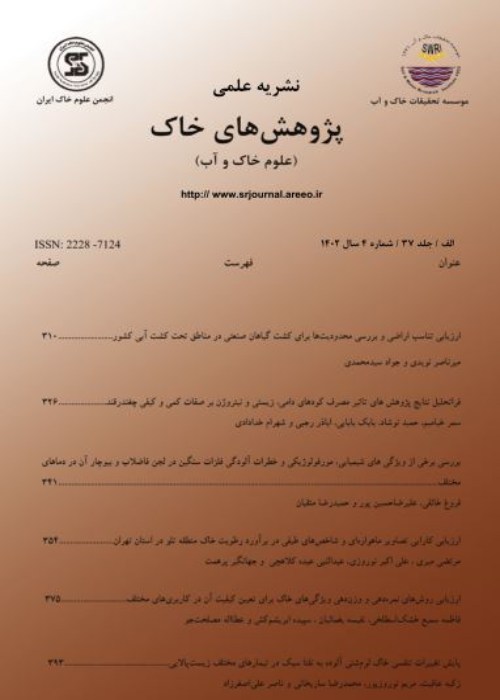A Comparative Study of the Effects of Sewage Sludge on Heavy Metals Concentrations and Some Morphological Characteristics of Lettuce
Author(s):
Abstract:
Use of sewage sludge as a cheap and nutrients-rich fertilizer has been common in some regions of Iran. But, using sewage sludge in large quantities can lead to accumulation of heavy metals in plant. The goal of this study was to evaluate the effects of sewage sludge on heavy metals concentrations in plants and some morphological characteristics of lettuce. This research was conducted in greenhouse of Faculty of Agriculture at Lorestan University. Treatments included five levels of sewage sludge: control (no sludge), 25, 50, 75 and 100 tons per hectare (t/ha), with four replications based on a completely randomized blocks design. Plant tissue analysis showed that sludge application significantly increased concentrations of Fe, Cu, Cd and Pb in lettuce shoot, root, and stalk. In 100 t/ha treatment, the highest concentrations of Fe (6.16 mg.kg-1) was in shoots and the highest concentrations of Cu and Pb, (1.49 and 1.20 mg.kg-1, respectively) was observed in the root and highest concentrations of Cd (0.43 mg.kg-1) was found in lettuce stalk. The results showed that application of sewage sludge significantly increased dry weight of biomass and root, plants height, root length, and leaf area index of lettuce, but had no significant effect on chlorophyll content. The highest amounts of these growth parameters were obtained in the treatment of 100 t/ha. Thus, because of concentration of heavy metals in sewage sludge, its long term application poses risk of heavy metal contamination in the soil and, consequently, health risk to the human and animal food chain. Therefore, according to the research results, it is recommended that sewage sludge should not be used for growing edible food crops. Indeed, before using sewage sludge in different farms, it is necessary to be examined for microbial load and suitable recommendations should be made based on local conditions, vegetation type, and soil characteristics.
Keywords:
Soil contamination , microbial load , yield , iron , Copper , lead , Cadmi
Language:
Persian
Published:
Iranian Journal of Soil Research, Volume:31 Issue: 2, 2017
Pages:
291 to 302
magiran.com/p1734620
دانلود و مطالعه متن این مقاله با یکی از روشهای زیر امکان پذیر است:
اشتراک شخصی
با عضویت و پرداخت آنلاین حق اشتراک یکساله به مبلغ 1,390,000ريال میتوانید 70 عنوان مطلب دانلود کنید!
اشتراک سازمانی
به کتابخانه دانشگاه یا محل کار خود پیشنهاد کنید تا اشتراک سازمانی این پایگاه را برای دسترسی نامحدود همه کاربران به متن مطالب تهیه نمایند!
توجه!
- حق عضویت دریافتی صرف حمایت از نشریات عضو و نگهداری، تکمیل و توسعه مگیران میشود.
- پرداخت حق اشتراک و دانلود مقالات اجازه بازنشر آن در سایر رسانههای چاپی و دیجیتال را به کاربر نمیدهد.
دسترسی سراسری کاربران دانشگاه پیام نور!
اعضای هیئت علمی و دانشجویان دانشگاه پیام نور در سراسر کشور، در صورت ثبت نام با ایمیل دانشگاهی، تا پایان فروردین ماه 1403 به مقالات سایت دسترسی خواهند داشت!
In order to view content subscription is required
Personal subscription
Subscribe magiran.com for 70 € euros via PayPal and download 70 articles during a year.
Organization subscription
Please contact us to subscribe your university or library for unlimited access!



